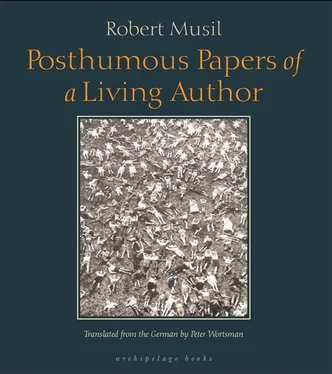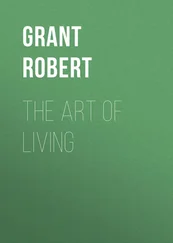Naturally this has some bearing on the much ridiculed absurdities of fashion, which one year make us longer and shorten us the next, which make us first fat and then skinny, sometimes wide on top and narrow on the bottom, sometimes narrow on top and wide down below, which one year prescribe that everything be combed upwards, and the next year insist that everything be combed back downwards again, impelling us now to brush our hair forwards and backwards, now to the right and to the left. If we consider it all from a wholly unsympathetic standpoint, fashion offers us an astoundingly limited number of geometric possibilities, among which we alternate in the most passionate way, without ever totally disrupting the tradition. If we likewise include the fashions of thought, feeling, and action, about which practically the same can be said, then our entire history must appear to the sensitized eye as nothing but a corral, within the confines of which the human hoard stampedes senselessly back and forth. And yet how willingly we follow the leaders, who themselves merely charge ahead of us out of terror, and what joy grins back at us in the mirror when we connect with the fashionable norm, looking exactly like everyone else, even though everyone looks different than they did yesterday! Why do we need all this?! Perhaps we fear, and rightfully so, that our character would scatter like a powder if we did not pack it into a publicly approved container.
The observer ended finally at foot level, that is, at the point where a man raised himself upright out of the animal domain. And how uncanny is that spot in the case of the communion between man and woman! We do after all have some prior knowledge of this sphere from the movies, in which famous heroes and heroines waddle rapidly toward us like ducks. But the cinema serves our love of life, and makes every effort to beautify its deficiencies, at which purpose it succeeds with ever greater technical proficiency. Not so our binoculars! They persist unrelentingly in showing us how ridiculously the legs disengage themselves from the hips and how clumsily they land on the heel and sole; not only does this organ swing inhumanly and land fat-end first, but it likewise manages meanwhile to effect the most revealing personal grimaces.
The man with his eye to the instrument noticed two such instances in the course of five minutes. Hardly had he aimed at a young fellow decked out in a sportscap (whose socks were striped like the neck of a ring dove), when he likewise noticed how with a concentrated and tiny jerk in each of his slow steps, this fellow knocked the leg of the girl sauntering beside him out of sync. No doctor, no girl, not even he himself had any inkling of the awful prospects that lay ahead; only the binoculars detached this tiny gesture of helplessness from the universal harmony of brutality and allowed the approaching figure to appear in the site! Something more harmless happened to the plump and friendly man in his prime who came quickly walking by and offered the world a kindly, obliging stride: according to a line down the middle of the site that neatly severed the legs one from another, it became apparent that his feet were repulsively twisted inwards; and now that at this one spot the curtain of truth had been lifted, one could see that his arms also swung selfishly in their shoulder sockets, that his shoulders tugged on the nape of his neck, and instead of revealing a benevolent overall appearance, all at once revealed a human system solely concerned with itself, a personality that couldn’t give a hoot about anyone else!
In this way, the binoculars contribute both to our understanding of the individual, as well as to an ever deepening lack of comprehension of the nature of humanity. By dissolving the commonplace connections and discovering new ones, it in fact replaces the practice of genius, or is at least a primary exercise. And yet perhaps for this very reason we recommend this instrument in vain. Do not people, after all, employ it even at the theater to heighten the illusion, or during intermission to see who else is there, thereby seeking not the unfamiliar, but rather, the comforting aspects of familiar faces?
It’s Lovely Here
There are many people who on their vacations are drawn to famous places. They drink beer in their hotel gardens, and if in addition they happen to make pleasant acquaintances, they already look forward to the memories. On the last day of their vacation they go to the nearest stationers; they buy postcards there, and then buy more postcards from the waiter back at the hotel. The picture postcards that these people buy look the same all over the world. They are tinted: the trees and lawns, poison green; the sky, peacock blue; the cliffs are gray and red. The houses are presented in downright painful relief, as though at any moment they might spring up out of the surface; and the color is so intense that a narrow band of it generally forms a contour on the flip side of the card. If the world really looked like that, one could indeed do nothing better than affix a stamp to it and toss it in the nearest mailbox. On these picture postcards people write: “It is indescribably beautiful here.” Or “It’s lovely here.” Or: “Too bad you couldn’t be here with me to see all this beauty.” Sometimes they also write: “You have no idea how beautiful it is here.” Or: “What a swell time we’re having here!”
You really do have to understand these people correctly! They are very happy indeed to be on a vacation trip and to see so many beautiful things that others cannot see; but it causes them pain and embarrassment actually to have to look at these things. If a tower is taller than other towers, a precipice deeper than the common precipice or a famous painting particularly large or small, that is all right, for the difference can be ascertained and talked about; it is for this reason that they tend to seek out a famous palace that is particularly spacious or particularly old, and among landscapes they prefer the wild ones. If you could only trick them about train schedules, hotel rates, and uniforms (but that is just what they would never fall for!), and set them down unawares on a cliff in the Saxon Switzerland, you could no doubt convince them to feel a genuine Matterhorn thrill, for surely Saxony is dizzying enough. If, however, something is not high, deep, large, small, or strikingly painted, in short, if something is not a phenomenon worth talking about, but merely beautiful, they choke — as though on a big smooth bite that will neither go up nor down, a morsel too soft to suffocate on, and too tough to let a word pass. Thus emerge those Oohs! and Ahs! painful syllables of suffocation. You cannot very well reach with your fingers down your throat; and we have not yet found a better means of getting the necessary words out of our mouth. It isn’t right to make fun of this. Such exclamations express a very painful feeling of constriction.
Experienced art commentators naturally have their own special techniques about which we might well have something to say; but this would be going too far. And, moreover, even the uncorrupted average man, despite the disagreeable effects of his constriction, feels a genuine satisfaction when standing face to face, as it were, with something that is acknowledged by experts as beautiful. This satisfaction has its own curious nuances. It contains for instance some of the same pride you feel when you can say that you passed the bank building at the very same hour when the famous bank robber X must have made his escape; other people already feel enraptured just to set foot in the city in which Goethe spent eight days, or to know the cousin by marriage of the lady who first swam the English Channel; there are indeed people who find it particularly wonderful just to live in such a momentous era. It always seems to revolve around a having-been-there; though in general it requires some element of complication, it must have an air of personal exclusivity. For as much as people lie, pretending to be completely engrossed in their occupations, they take a childish delight in personal experiences and that incalculable sense of importance that such experiences give us. It is then that they feel touched by their own “personal destiny,” which is an altogether extraordinary thing: “He was just talking to me at that very moment when he slipped and broke his leg. .!” What they feel, were they to be able to put it into words, is as if, behind that great blue window with the cloud curtains, someone had been standing a long time watching them.
Читать дальше











